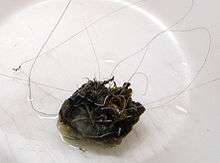Endovascular coiling
Endovascular coiling, or endovascular embolization, is an endovascular treatment for aneurysms and bleeding throughout the body. It is one of two main treatments for cerebral aneurysms, the other being surgical clipping. It is an alternative to stenting for bleeding.
Indications
Endovascular coiling is used to treat cerebral aneurysms. The main goal is prevention of rupture in unruptured aneurysms, and prevention of rebleeding in ruptured aneurysms. In ruptured aneurysms, coiling is performed quickly after rupture because of the high risk of rebleeding within the first few weeks after initial rupture. The patients most suitable for endovascular coiling are those with aneurysms with a small neck size (preferably <4 mm), luminal diameter <25 mm and those that are distinct from the parent vessel.[1] However, technological advances have made coiling of many other aneurysms possible as well.
Mechanism
The treatment works by promoting blood clotting around the coils, eventually sealing the aneurysm and reducing pressure on its outer wall.
Procedure

Endovascular coiling is usually performed by an interventional neuroradiologist with the patient under general anaesthesia. The whole procedure is performed under fluoroscopic imaging guidance. A guiding catheter is inserted through the femoral artery and advanced to a site close to the aneurysm after which angiography is performed to localize and assess the aneurysm. After this, a microcatheter is navigated into the aneurysm.
The treatment uses detachable coils made of platinum that are inserted into the aneurysm using the microcatheter. A variety of coils are available, including Guglielmi Detachable Coils (GDC) which are platinum, Matrix coils which are coated with a biopolymer, and hydrogel coated coils. A series of progressively smaller coils are inserted into the aneurysm until it is completely filled. In the case of wide-necked aneurysms a stent may be used.
Results
A number of studies have questioned the efficacy of endovascular coiling over the more traditional surgical clipping. Most concerns involve the chance of later bleeds or other recanalization.[2][3][4] Due to its less invasive nature, endovascular coiling usually presents faster recovery times than surgical clipping.
A 2007 study by Jacques Moret and colleagues indicates that 28.6% of aneurysms recurred within one year of coiling, and that the recurrence rate increased with time.[5] These results are similar to those previously reported by other endovascular groups.[6] Other studies have questioned whether new matrix coils work better than bare platinum coils.[7]
International Subarachnoid Aneurysm Trial
The International Subarachnoid Aneurysm Trial, or ISAT, was a large clinical trial that tested the efficacy of endovascular coiling against the traditional micro-surgical clipping. The study initially found very favorable results for coiling, however its results and methodology were criticized. Since the study's release in 2002, and again in 2005, some studies have found higher recurrence rates with coiling, while others have concluded that there is no clear consensus between which procedure is preferred.[8]
Risks and complications
Risks of endovascular coiling include stroke, aneurysm rupture during the procedure and aneurysm recurrence and rupture after the procedure.[1] Additionally in some patients coiling may not be successful. In general, coiling is only performed when the risk of aneurysm rupture is higher than the risks of the procedure itself.
History
Endovascular coiling was developed in 1991 by Guido Guglielmi at UCLA. In 1965 the use of electrically induced thrombosis for intracranial aneurysms was described for the first time.[1] However, the microcatheters necessary for this procedure only became available in the late eighties. The use of detachable coils was first described in 1991 by Guglielmi et al.[1] In recent years, coiling has gradually become an important alternative to surgical clipping.
References
- 1 2 3 4 Currie, S; Mankad, K; Goddard, A (Jan 2011). "Endovascular treatment of intracranial aneurysms: review of current practice.". Postgraduate Medical Journal. 87 (1023): 41–50. doi:10.1136/pgmj.2010.105387. PMID 20937736.
- ↑ J Neurointerv Surg. 2011 Apr 27. [Epub ahead of print]
- ↑ Campi A, Ramzi N, Molyneux AJ, Summers PE, Kerr RS, Sneade M, Yarnold JA, Rischmiller J, Byrne JV (May 2007). "Retreatment of ruptured cerebral aneurysms in patients randomized by coiling or clipping in the International Subarachnoid Aneurysm Trial (ISAT).". Stroke. 38 (5): 1538–44. doi:10.1161/STROKEAHA.106.466987. PMID 17395870.
- ↑ Mitchell P, Kerr R, Mendelow AD, Molyneux A. Could late rebleeding overturn the superiority of cranial aneurysm coil embolization over clip ligation seen in ISAT?" Journal of Neurosurgery 108: 437-442, March 2008. But see, J Mocco, L. Nelson Hopkins, "International Subarachnoid Aneurysm Trial analysis", Journal of Neurosurgery, March 2008 / Vol. 108 / No. 3 / Pages 436-436.
- ↑ Piotin, M; Spelle, L; Mounayer, C; Salles-Rezende, MT; Giansante-Abud, D; Vanzin-Santos, R; Moret, J (May 2007). "Intracranial aneurysms: treatment with bare platinum coils—aneurysm packing, complex coils, and angiographic recurrence.". Radiology. 243 (2): 500–8. doi:10.1148/radiol.2431060006. PMID 17293572.
- ↑ Raymond, J; Guilbert, F; Weill, A; Georganos, SA; Juravsky, L; Lambert, A; Lamoureux, J; Chagnon, M; Roy, D (June 2003). "Long-term angiographic recurrences after selective endovascular treatment of aneurysms with detachable coils.". Stroke. 34 (6): 1398–1403. doi:10.1161/01.STR.0000073841.88563.E9. PMID 12775880.
- ↑ Piotin M, Spelle L, Mounayer C, Loureiros C, Ghorbani A, Moret J. Intracranial aneurysms coiling with matrix. Immediate results in 152 patients and midterm anatomic follow-up from 115 patients. Stroke November 2008 (e-pub ahead of print)
- ↑ Raja PV, Huang J, Germanwala AV, Gailloud P, Murphy KP, Tamargo RJ (2008). "Microsurgical clipping and endovascular coiling of intracranial aneurysms: A critical review of the literature". Neurosurgery. 62: 1187–1202. doi:10.1227/01.neu.0000333291.67362.0b. PMID 18824986.
- Adnan I. Qureshi, Alexandros L. Georgiadis, Textbook of Interventional Neurology, Cambridge University Press, 2011, ISBN 0-521-87639-7.